 W
WBanja Monastery is a Serbian Orthodox Monastery located near Priboj, Serbia. Monastery Banja presents Cultural Monument of Exceptional Importance in Serbia.
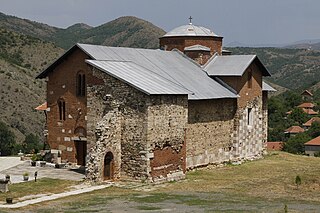 W
WBanjska Monastery is a Serbian Orthodox monastery in the Banjska village near Zvečan in Kosovo.
 W
WThe Church of Holy Apostles Peter and Paul, known as the Cave Church, is a Serbian Orthodox cave-church located on eastern slope of Mount Kopaonik near Lukovo, southern Serbia. it was built by the Serbian King Milutin in the 14th century and is dedicated to Saints Peter and Paul. It is part of the Monastery of St. Archangel Gabriel.
 W
WThe Church of St John the Baptist also known as the Churhc of St. Lazar in Samodreža, six kilometers east of Vučitrn, Kosovo, is a Serbian Orthodox Church dedicated to the Beheading of St John the Baptist. The church mentioned in the Serbian tradition as the location where the army of Prince Lazar gathered for the Battle of Kosovo (1389). The current building was built in 1932 and was heavily damaged by the Albanians during the Kosovo War and 2004 unrest.
 W
WChurch of St. Nicholas was a Serbian Orthodox church located in the village of Đurakovac in the municipality of Istok, in Kosovo. It was built on the foundations of an older building from the 14th century, and completely rebuilt in 1592 by the villagers, led by the priest Cvetko. The church belongs to the Eparchy of Raška and Prizren of the Serbian Orthodox Church and is registered as a Cultural Heritage of Serbia.
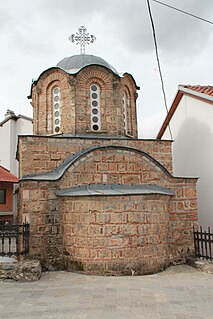 W
WThe Church of St. Nicholas, also known as Tutić Church is an Orthodox church located in Prizren in Kosovo. It was founded in 1331-1332 by Dragoslav Tutić, whose monastic name was Nikola (Nicholas), and his wife Bela. Later, the church became a possession of the Visoki Dečani Monastery. Since 1990, it has been on Serbia's list of Monuments of Culture of Exceptional Importance. At the time of the 2004 unrest in Kosovo, the church was vandalized. Since 2005, with financial support from the European Union, work has been undertaken to restore the church to its original state.
 W
WThe Church of the Holy Archangels is a former 14th-century Serbian Orthodox church in Gornje Nerodimlje near the city of Uroševac, Kosovo. It is listed as a Cultural Monument of Exceptional Importance of the Republic of Serbia. It was destroyed by Albanians during the Kosovo War.
 W
WThe Church of the Holy Saviour is a Serbian Orthodox church located in Prizren, Kosovo, built around 1330.
 W
WThe Church of the Virgin Hodegetria was a 14th-century Serbian Orthodox church in Mušutište, near Suva Reka, Kosovo, that was destroyed by Kosovar Albanian forces during the destruction of the Serbian part of Mušutište, after the end of the Kosovo war in 1999.
 W
WDivljana Monastery, also known as the Monastery of St. Demetrius, is a Serbian Orthodox monastery located near the village of Divljana and Divljana Lake, 5 km (3.1 mi) south of Bela Palanka, in the foothills of Suva Planina, 450 m (1,480 ft) above sea level. It is dedicated to St. Demetrius, who is celebrated on 8 November. The monastery was first built in 394 at this location, which became the property of the Mrnjavčević brothers at the end of the 13th century after the destruction of the monastery. In the monastery complex, there are records of ancient burials from the 4th century, some of which can be seen two of the capitals. Around 880, with the revival of Christianization, there were also new eparchies. Based on physical evidence and the Charter of the Byzantine emperor Basil II, archaeologists believe that the site also included an early Christian building from the 9th century related to a renewal of church life in Middle Ponišavlje.
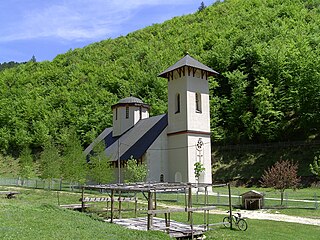 W
WThe Glogovac Monastery is a Serbian Orthodox monastery dedicated to Saint George and located at the village of Babići near Šipovo in the Republika Srpska entity of Bosnia and Herzegovina. It is the only monastery in this area. The original building was destroyed in 1463 when this region was occupied by Ottoman Turks.
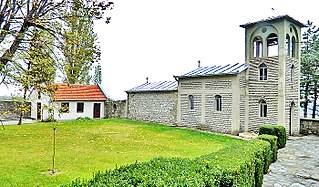 W
WGorioč Monastery is Serbian Orthodox Monastery in Kosovo and Metohia region, metohion (dependency) of Visoki Dečani Monastery. By tradition it was founded in 14. c by Serbian King Stefan Dečanski, as a gift to St. Nicholas for the healing. Gorioč Monastery is situated on Bela Stena, near Istok. Around Monastery church dedicated to St. Nicholas, there are dormitories for nuns and guests as well as bell tower, small economic buildings and fishpond.It depends on the eparchy of Ras-Prizren and appears on the list of cultural monuments of exceptional importance of the Republic of Serbia. The convent complex includes a church, dedicated to Saint Nicholas, a bell tower and the monks' refectory.
 W
WThe Gornjak Monastery, formerly known as Ždrelo (Ждрело), is a 14th-century Serbian Orthodox monastery located in the vicinity of today's city of Petrovac na Mlavi, Serbia.
 W
WKoroglaš monastery is an abandoned 14th century Serbian Orthodox monastery in the village of Miloševo, Negotin, Serbia, thought to have been founded by Serbian king Stefan Milutin of the Nemanjić dynasty or by Mircea I of Wallachia. Legend says that King of Prilep Prince Marko was buried here after returning from the Battle of Rovine against Mircea I of Wallachia in 1395. The same legend mentioned that Mircea the Elder of Wallachia erected the monastery in memory of Christians killed in the battle of Rovine and in memory of Marko A medieval necropolis of the monastery is partly excavated.
 W
WKrka Monastery is a Serbian Orthodox monastery dedicated to the Archangel Michael, located near the river Krka, 3 km east of Kistanje, in central Dalmatia, Croatia. It is the best known monastery of the Serbian Orthodox Church in Croatia and it is officially protected as part of the Krka National Park.
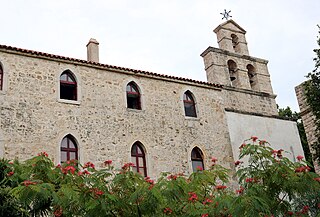 W
WKrupa monastery is a Serbian Orthodox monastery on the Krupa River in Croatia. It is the oldest Orthodox monastery in Croatia.
 W
WChurch of the Holy First Martyr Stephen, better known as the Lazarica Church, is a Serbian Orthodox church in Kruševac, Serbia. It was built in 1375-1378 as an endowment of prince Lazar of Serbia. Lazarica, as an outstanding achievement of the Serbian medieval architecture, was declared a Monument of Culture of Exceptional Importance in 1979, and it is protected by the Republic of Serbia. Lazarica was built as a prototype of the Morava school of architecture, as a palace church associated with the Kruševac Fortress, the capital of Prince Lazar. Today, only Lazarica and parts of the keep remain from the vast fortress complex.
 W
WLjubostinja is a Serbian Orthodox monastery near Trstenik, Serbia. Located in the small mountain valley of the Ljubostinja river, the monastery is dedicated to the Holy Virgin.
 W
WThe Monastery of the Most Holy Mother of God, commonly known as Matejče (Матејче) or Matejić (Матејић), is a 14th-century Serbian Orthodox monastery located in the village of Matejče on the slopes of Skopska Crna Gora, near Skopje and Kumanovo. The village is inhabited by 89% Muslim Albanians and 10% Orthodox Serbs.
 W
WThe Monastery of the Holy Archangels is a Serbian Orthodox monastery located in Prizren, in Kosovo, founded by the Serbian Emperor Stefan Dušan between 1343 and 1352 on the site of an earlier church, part of the Višegrad fortress complex. It was the burial church for Emperor Dušan, and represented the culmination of the Serbian ecclesiastical architectural style, that led to the birth of the Morava school style.
 W
WOur Lady of Ljeviš is a 14th-century Serbian Orthodox church in the town of Prizren, in southern Kosovo. Since 2006, the church is part of the UNESCO World Heritage Site named Medieval Monuments in Kosovo.
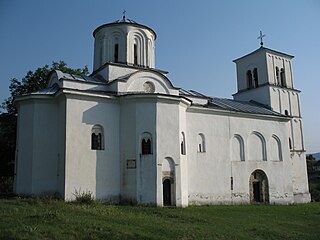 W
WThe Nova Pavlica is a 14th-century Serbian Orthodox monastery located in Pavlica, Raška, in southwestern Serbia. It belongs to the Eparchy of Žiča. The monastery is located near Stara Pavlica, near river Ibar and near old town of Brvenik.
 W
WPodlastva Monastery or The Monastery of Podlastva is a medieval, women's Serbian Orthodox monastery located in Lastva Grbaljska, in Grbalj, near the coast of Montenegro. The monastery's church is dedicated to the Birth of the Most Holy Theotokos.
 W
WThe Poganovo Monastery of St. John the Theologian is a Serbian Orthodox monastery situated in the gorges of the river Jerma, near the village Poganovo, municipality of Dimitrovgrad, Serbia.
 W
WPraskvica Monastery is a Serbian Orthodox monastery in Čelobrdo, a village in the Budva municipality in modern-day Montenegro. It was a spiritual and political center of the Paštrovići clan. The name of the monastery is taken from the peach-scented water of the nearby spring.
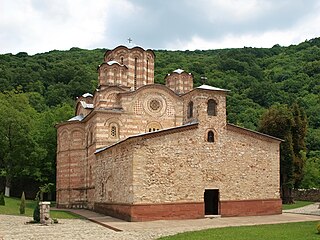 W
WRavanica is a Serbian Orthodox monastery on Kučaj mountains near Senje, a village in Ćuprija municipality in Central Serbia. It was built in 1375–1377 as an endowment of prince Lazar of Serbia, who is buried there. The Ravanica church is called the birthplace of the new artistic movement "Morava school" because of architectural and artistic features. It is original blend of the Mount Athos and the cross-in-square five-domed model that became standard in the time of King Milutin.
 W
WThe Tronoša Monastery is a Serbian Orthodox monastery between the villages of Tršić and Korenita, in the administrative town of Loznica, in western Serbia. It is ecclesiastically part of the Eparchy of Šabac. According to tradition, the monastery was built by King Stefan Dragutin.
 W
WThe Tuman Monastery is a 14th-century Orthodox monastery in eastern Serbia, in the municipality of Golubac. It belongs to the Serbian Orthodox Eparchy of Braničevo. It is also referred to as the Tumane Monastery.
 W
WVeluće is a village located in the Trstenik municipality, central Serbia. According to the 2011 census, the village has a population of 417 inhabitants.
 W
WVisoki Dečani, or simply Dečani, is a medieval Serbian Orthodox Christian monastery located near Decan, Serbia. It was founded in the first half of the 14th century by Stefan Dečanski, King of Serbia.
 W
WThe Vojlovica Monastery is a Serb Orthodox monastery situated in the Banat region, in the northern Serbian province of Vojvodina. It is in the Pančevo municipality. It was founded during the time of Despot Stefan Lazarević (1374-1427).
 W
WVratna monastery, now Vratna nunnery (Вратна) is a 14th-century Serbian Orthodox monastery in the village of Vratna in Negotin, Serbia, founded by Serbian king Stefan Milutin (1282–1321) of the Nemanjić dynasty and Saint Nikodim I. It is situated below the Vratna canyon and the nearby Vratna river flows through the village.
 W
WThe White Church of Karan is a Serbian Orthodox parish church in the village of Karan, Užice Municipality, Serbia. It is dedicated to the Annunciation to Mary. The church was listed as a Cultural Monument of Great Importance.